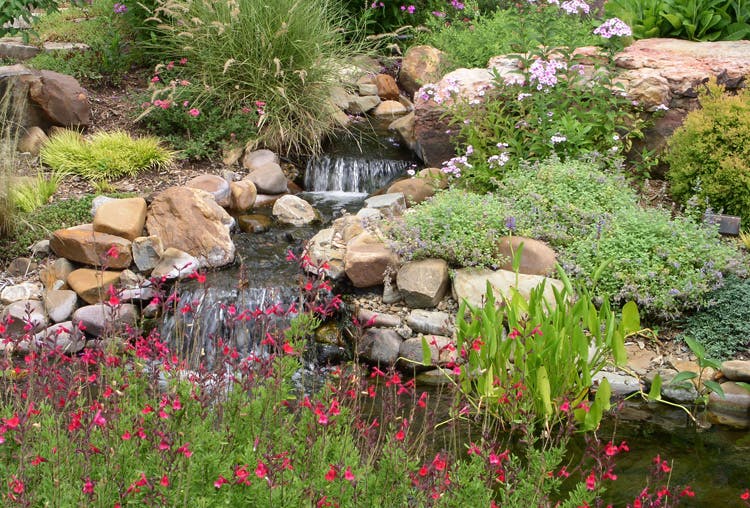Since ancient times, gardeners have used pools, ponds, and fountains to provide interest and refreshment in their gardens. Today, with the available modern materials, it is easier than ever to have a water feature in your garden.
The design possibilities are limitless and should be guided by your personal taste as well as the style of your house and neighborhood. For inspiration, look to modern minimalist projects as well as historic looks designed by the landscape masters of the past.
GLOBAL INSPIRATION
Take a tip from the Persians with intersected narrow waterways on an axis. Add a pond at the intersection and a fountain to enhance the garden experience with the music of falling water and a cooling element.
The sixteenth-century Italians mastered the art of gardening on a slope with terraced gardens and water features designed to flow downhill from one terraced garden level to the next. These gardens were embellished with sculptural fountains, waterways, and pools.
The French adapted the Italian water designs to their flat, local landscape, creating vast horizontal canals and reflecting pools. The impressive garden at Versailles features a canal that stretches to the horizon, thus creating enormous perspectives and reflecting the ever-changing patterns of the sky.
The Romantic movement of the eighteenth century reflected the English desire to be at one with nature. Instead of formal pools, the English estate gardens were graced with informal, naturalistic ponds and lakes. These lakes were nearly always man-made and involved Herculean feats of earth moving to create the basins and dams to hold the water, but when finished they looked as though they had been there since the beginning of time.
Asian gardens also tend to be naturalistic, but their plant palette and ornaments reflect a different overall approach to the final product.
FOUNTAINS AND WATERFALLS
Fountains and waterfalls add an element of magic to a garden. A pattern of falling water, which catches the sunlight and makes a musical sound, is delightful and soothing to both the eye and ear. If you have noisy neighbors or live on a busy street, install a splashing fountain to help mask the noise.
Natural rock formations, statues, and millstones drilled and piped for water are possibilities for appealing fountains; the water jets alone are pretty. You can select a fountain head to make almost any imaginable pattern of falling water from single sprays, multitiered sprays, whirling sprays, geysers, bells, fanned fishtails, flared trumpets, and multiple sprays resembling a dandelion seed head. In addition to the visual variations, each type of spray or jet makes a different sound.
Waterfalls also provide a wonderland of possibilities. Channel the water to trickle around stones or cascade over a smooth rock edge to create a smooth ribbon of falling water. You can make it splash and crash from a great height or run it down the slope quietly. Position rocks so that droplets of water falling from up high splinter into a fine mist, creating rainbows with the spray. Another possibility is to create a slender stream of falling water, known in Oriental landscape design as a silver thread.
There are good reasons to introduce a water feature to your garden. Watching water, whether still or moving, soothes the soul and refreshes the spirit, as does the sound of falling water. Water cools and humidifies the air directly around it, creating a beneficial microclimate for plants that require respite from drying heat. Still pools are magical with their reflections, and falling water can be designed to produce a myriad of sounds from a soothing splash to an incessant chatter.
What to Avoid
Trees and shrubs don’t always pair well with ponds. In addition to soiling the pond by dropping leaves into the water, some plants can cause additional problems.
On the “no-no” list are holly, laurel, rhododendron, horse chestnut, and willow. Their leaves produce salts and gasses when they decompose, by-products that are toxic to fish. Any tree with invasive roots can damage pond linings. The worst offenders are willows, American elms, silver maples, and hybrid poplars.
If you are growing water lilies, do not plant cherry, plum, or any other tree from the Prunus genus nearby. They are hosts to the water lily aphid.
Trees prone to drop fruit or shed leaves, dead twigs, or seed pods are a bad choice near ponds. Avoid ucalyptus, pecans, catalpa, magnolias, American sycamore, and river birch. Pine trees that shed all year round also are a poor choice. In addition to the mess, the needles can clog pumps and backflow valves.
Article by Homebydesign.



